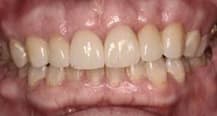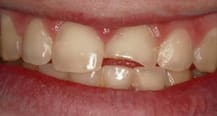View Our Smile Gallery
Full Contour Crowns
These two cases are full crowns to improve esthetics and strength of teeth. Full-contour crowns are necessary in cases of worn or moderately misaligned teeth, and they require more preparation of the teeth than veneers. But they are a great deal stronger than veneers and will last much longer.
Both cases below involved laboratory-made crown restorations, with a turn-around time of about 2 weeks, and temporary crowns were worn while the permanents were being fabricated. Temporaries can be very beneficial for the patient because they provide a “trial run” of their new teeth – to verify the shade, contour, and length of the restorations are satisfactory for the patient before the permanent crowns are fabricated. While many people do not like the idea of wearing temporaries, they often save time and money in the long run.
Case #1
This patient had her front six teeth restored with full crowns. She was not satisfied with her smile because of the chipping edges and misalignments leading to an uneven smile. She now wears a bite guard when she sleeps to protect her restorations and other teeth from nighttime tooth bruxism.
Laboratory Veneers
Laboratory-made porcelain veneers are a long-term solution for esthetic issues such as color and shape with the front teeth. Teeth are prepared for veneers with very minor reduction of tooth structure, ideally only a fraction of the enamel is removed. This is more conservative than full-contour crowns which typically require most or all of the enamel removed. Preparation time varies patient to patient, on average it may take two to three hours for preps, digital impressions, and temporization. Temporary veneers are typically worn for the two weeks of lab fabrication, a great trial period with their new smile. Permanent veneer cementation usually takes about an hour, depending on the number of teeth.
Case #1
This patient had severe wear on all front teeth and several spaces between teeth. She decided to veneer nine of her upper teeth and eight of her lower teeth to upgrade her smile. She now wears an occlusal guard when she sleeps to protect this very beautiful dentistry from her very damaging nighttime bruxism (grinding).
Case #2 – Peg Laterals
This patient had short and skinny lateral teeth, called peg laterals. Because the teeth were too small, there were dark spaces in between her front teeth that she disliked. She had composite material bonded to her teeth in the past to make them appear slightly larger, but the material had begun to discolor and the spaces were still noticeable. The teeth were prepared and the gum tissue was reshaped so that the new teeth would appear as long as her two central teeth. The veneers have the unique color character of her natural teeth, with different tones and highlights, to match the rest of her smile.
Chairside Veneers
Chairside Veneers are restorations which are completed in-office during a single appointment. They are constructed by hand using light-cured composite resin and then adjusted and polished for function and smoothness. When done properly, they will mimic and blend with nature tooth structure and provide very esthetic results. For most patients, these restorations can last for many years when well taken care of. For patients who enjoy high-staining drinks like coffee, tea, or red white, the composite can discolor over time – possibly requiring additional polishing or replacement. Patients with less-than ideal occlusion or who bite their nails or open things with their teeth will likely fracture this material, since it is not as strong as lab-made veneers.
Case #1
TThis patient bit down on a fork and broke off a filling (or bonding) that had replaced the missing corner of his front tooth. The tooth was alive and painless, so the tooth was fixed that same day with a chairside veneer. In addition to the bottom edge of the tooth, the entire front of his tooth was covered with composite and polished smooth. This technique blends and camouflages the edge of the restoration and also provides for more surface area and a stronger bond.
Diastema Closure
A diastema is a space between the teeth, most commonly between the two upper front teeth. Usually, people with diastemas have smaller front teeth or tough gum tissue which keeps the tooth roots too far apart. Some patients may have had their diastemas closed through orthodontics, only to have them spring back open once the braces were removed – even while wearing a retainer! When correcting a diastema, it is best to be conservative a gentle to these otherwise healthy teeth. Simply bonding composite to the enamel of the teeth will close the space without an invasive drilling. The bondings are polished and contoured, so they can be flossed and maintained just like any other tooth. When properly done and maintained, they are almost impossible to discern from natural tooth enamel and last for years. As with Chairside Veneers, high-stain liquids can cause discoloration, but this can usually be polished away from the surface.
Case #1
This patient had a diastema her whole life but didn’t want to go through orthodontics or expensive/invasive dental procedures to fix it. In one day, she had the bondings done and hasn’t needed any polishing or buffing since.
Case #2 – Peg Laterals
This patient had orthodontics when he was a teenager and wore his retainer for a few years afterward. His diastema opened back up in his twenties, and he had lost his retainer. He didn’t want veneers or anything that would drill his enamel away, and he definitely didn’t want to go through ortho again. His bondings were completed in about 45 minutes. He is a big fan of tea and Diet Coke, so he did have his bondings polished at a hygiene visit a couple of years after they were done.
Botox®
Botox®Cosmetic is prescribed for the esthetic softening of set wrinkles and delivered by trained medical professionals – including dentists. Every patient has different muscle tone and tissue elasticity, so every patient has a unique plan for the quantity and frequency of Botox injections. Both vertical “frown lines” between the eyebrows and horizontal “worry lines” on the forehead can be dramatically reduced using this unique and reversible treatment. The cases below each involved 20 units of Botox, and the Before and After images were taken 3 weeks apart. For most patients, these results are enjoyed for 3-4 months. Again, every patient is unique, and these results may vary.
Side Note: Botox® can also be used to treat severe TMJ-related muscle pain because it relaxed over-exerted muscles in the jaw. Onset of relief is usually 2-3 weeks, with most patients remaining comfortable for up to 4 months. In most cases, the pairing of Botox with occlusal guard therapy can relieve jaw and headache pain significantly for our patients.
Ready to get started?
Book your appointment
Give us a call
(904) 269-6558
or send us a message using the form below


















